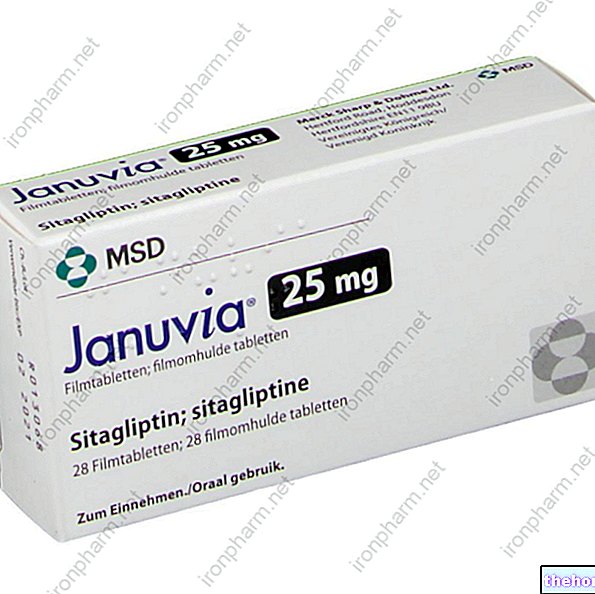
In order to exert its action, exenatide must be administered parenterally by subcutaneous injection. Medicines containing it can only be dispensed upon presentation of a repeatable limitative medical prescription - RRL (drugs sold to the public on prescription from hospitals or medical centers). However, these medicines are classified as class A drugs, therefore, their cost can be reimbursed by the National Health System (SSN).
Did you know that ...
Exenatide is currently being studied as a possible drug to be used in the treatment of Parkinson's disease. Recent studies have, in fact, shown that the administration of this active ingredient in patients suffering from the aforementioned pathology is able to induce an improvement of the same However, the same researchers who worked on it affirm that further and more in-depth research is needed before approving such a use of exenatide, in order to accurately assess its real efficacy and actual safety of use in individuals with the disease. Parkinson's.
Examples of Specialty Medicines containing Exenatide
- Bydureon®
- Byetta®
Exenatide is normally used in combination with other antidiabetic drugs, such as:
- Sulfonylureas;
- Metformin;
- Thiazolidinediones;
- Type 2 sodium-glucose transporter inhibitors;
- Long-lasting insulin.
Please Note
The dietary treatment and exercise program established for disease control should NOT be discontinued even if you are taking antidiabetic drugs. The latter, in fact, must be used in association with a normoglycemic diet and regular physical activity and NOT in their place.
in order to promptly identify the onset of hypoglycemia.In any case, as a precaution, before taking exenatide-based medicines, it is advisable to inform the doctor of your health conditions, making him aware of the possible presence of disorders or diseases of any kind, even if not listed in the above list .
Please Note
- The use of exenatide in children and adolescents less than 18 years of age is not recommended, as there are insufficient data on the use of the active substance in this category of patients.
- When exenatide is used in combination with a sulphonylurea there is a risk of hypoglycaemia whose symptoms may interfere with the ability to drive and use machines; therefore, extreme caution is recommended.
In any case, before starting exenatide therapy, you should tell your doctor if you are taking, or have recently taken, any drugs or products of any kind - even if not listed above - including medicines without prescription (SOP), over-the-counter drugs (OTC), herbal and phytotherapeutic products and homeopathic products.
Furthermore, since exenatide slows gastric emptying, it is necessary to ask the doctor if it is necessary to change the time of taking any other drugs, such as:
- Gastro-resistant tablets and capsules (for example, proton pump inhibitors);
- Some types of antibiotics;
- Medicines that must be taken with food.
The doctor will explain to the patient how to change the timing of taking such medicines.
experiencing undesirable effects that differ in type and intensity, or not showing them at all.Very common and common side effects
Among the very common and common side effects that can occur during therapy with exenatide, we find:
- Nausea (especially during the initial stages of treatment) and / or vomiting;
- Diarrhea;
- Hypoglycemia which can manifest with symptoms such as:
- Headache;
- Drowsiness;
- Weakness;
- Dizziness
- Confusion:
- Irritability;
- Feeling of hunger;
- Rapid heartbeat;
- Sweating and nervousness.
As stated several times in the article, the risk of hypoglycaemia is real especially when exenatide is administered in combination with sulfonylureas.
- Headache;
- Dizziness
- Loss of strength and energy, tiredness and fatigue;
- Abdominal pain;
- Constipation;
- Stomach ache;
- Indigestion and flatulence;
- Swelling;
- Reduction of appetite;
- Reactions at the injection site.
Uncommon and rare side effects
However, the less common and rare side effects that may arise during treatment with exenatide include:
- Severe allergic reactions which can manifest with symptoms such as:
- Angioedema;
- Skin rashes, itching and rapid swelling of the tissues of the neck, face, mouth or throat;
- Difficulty swallowing
- Urticaria;
- Respiratory difficulties.
Of course, in such situations, the doctor must be informed immediately.
- Inflammation of the pancreas which can be life-threatening and which can manifest itself as severe and persistent pain in the stomach, with or without vomiting. Again, the doctor should be alerted immediately.
- Decreased kidney function;
- Dehydration;
- Intestinal obstruction;
- Belching;
- Perception of a strange taste in the mouth;
- Increased sweating;
- Hair loss
- Drowsiness
- Nervousness;
- Variations of the INR.
Overdose
In the event of an overdose of exenatide, the following may occur:
- Severe nausea and / or vomiting;
- Rapid reduction in blood sugar.
There is no specific antidote, treatment will only be symptomatic and supportive and should be started as soon as possible. Therefore, in the event of overdosing - whether it is ascertained or presumed to be - it is necessary to contact your doctor immediately or go to the nearest hospital, taking the package of the medicine taken with you.
particular hormones called incretins are produced whose levels increase following food intake. There are basically two types of incretins: GLP-1 (Glucagon-like peptide 1) and GIP (Glucose-dependent insulinotropic peptide). GLP-1, in particular, is responsible for blood sugar control, especially after meals.Exenatide exerts an agonist action against the receptor for incretin GLP-1, mimicking the action of the endogenous substrate GLP-1 (hence the name of "incretin mimetics"). More specifically, by doing so, exenatide is able to increase the secretion of insulin by the beta cells of the pancreas in a glucose-dependent manner (as blood sugar decreases, insulin secretion is reduced) and to suppress the secretion of glucagon whose concentration is elevated in patients with type 2 diabetes. Lower glucagon concentrations lead to a reduction in hepatic glucose output.
, or in the thigh, or again in the upper arm.
If it is also necessary to take insulin, the administration of the two drugs must not take place at the same time and the two injections must not be given close together.
Extended-release exenatide (Bydureon®)
Prolonged-release exenatide should be injected once a week (always on the same day), at any time of the day and regardless of meals.
The powder and solvent for suspension for injection must be mixed just before giving the injection. Before starting to mix the two components, it is necessary to check that the solvent is clear and free of particles. After mixing, the suspension can be used only if the mixture appears white to off-white and cloudy. If powder particles are visible on the walls or bottom of the vial - or the pen, as the case may be -, it means that the medicine is NOT mixed well. In this case therefore, the vial or pen must be shaken vigorously again until the medicine is mixed well.
The suspension for injection in pre-filled pen should be stored in the refrigerator. When it is necessary to administer exenatide, the syringe should be removed from the refrigerator and left in a horizontal position for at least 15 minutes, after which the suspension should be mixed by shaking the pen for at least 15 seconds. Again, the suspension should only be used if properly mixed; if you see white particles on the walls or bottom of the syringe, you need to shake it again.
If using the vial, the needle must be changed and new with each injection. The same applies to the pre-filled pen.
Forgetfulness of a dose
If you forget to take a dose of exenatide, it can work in different ways depending on the day you are:
- If a dose is forgotten and there are still 3 or more days left until the next dose is given, the missed dose can be given as soon as possible. After that, for the next injection you can go back to administering the drug on the day chosen for the injections.
- If a dose is forgotten and there are still 1 or 2 days left until the next dose, the missed dose should be skipped and the next dose given as usual on the appointed day instead. If desired, it is also possible to change the day chosen to give the injection, provided that the last dose was given 3 or more days before. Two injections of exenatide should not be given within three days of each other.
Exenatide solution for injection (Byetta®)
The solution for injection should be administered at any time within 60 minutes before the morning and evening meal (breakfast and dinner), or before the two main meals of the day which however must be at least 6 hours apart. The solution for injection should NOT be administered after a meal.
The dose usually administered is 5 micrograms (mcg) of exenatide twice daily. After 30 days at this posology, the doctor may decide to increase the exenatide dose given to 10 micrograms twice daily.
Forgetfulness of a dose
If a dose of exenatide in the form of a solution for injection is forgotten, this dose should be skipped; the next dose should be administered as prescribed by the doctor. An additional dose should not be used and the amount of exenatide should not be increased during subsequent administration to make up for a forgotten dose.
The doctor or nurse at the diabetes center will teach the patient how to administer exenatide. Detailed information on this is also reported on the package leaflets of the medicines and on the official website of the AIFA (Italian Medicines Agency): Instructions for the use of Bydureon® - Instructions for the use of Byetta®.
and on the baby, the active ingredient should not be used by pregnant women and mothers who are breastfeeding.If you decide to become pregnant, treatment with exenatide must be stopped at least three months before the start of gestation. In such cases, therefore, it is advisable to contact your doctor or gynecologist who will provide all the appropriate information.









.jpg)


















